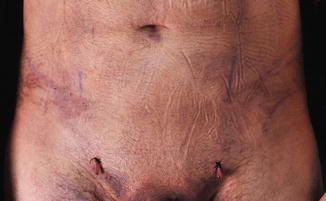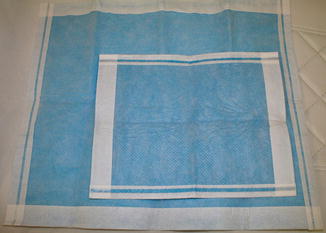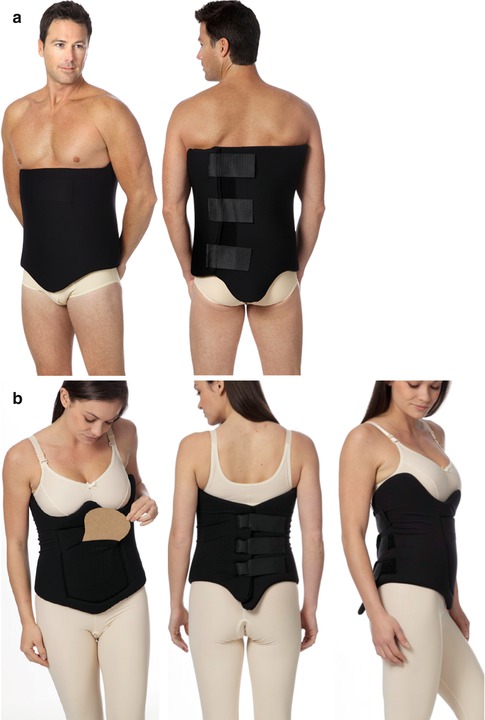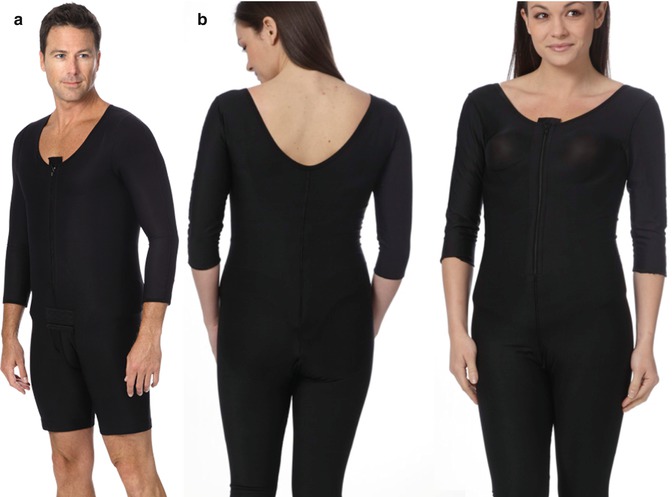and Peter M. Prendergast2
(1)
Elysium Aesthetics, Bogota, Colombia
(2)
Venus Medical, Dublin, Ireland
In order to achieve excellent results and minimize complications in high-definition body sculpting, a comprehensive postoperative care regimen should be prescribed. Complications and suboptimal results arising from internal ultrasound, extensive superficial and deep lipoplasty, and large-volume fat transfer can be avoided or reduced by implementing a plan of appropriate care and therapies in the postoperative period. These include advice, medications, drainage, compression, massage, and external energy-based procedures. To ensure success, the importance of compliance with postoperative care and attending postoperative visits must be explained to the patient during preoperative consultations. It is useful to remind the patient that results are obtained not only by the operative procedure but also by adhering to a laborious recovery care schedule.
Targets of Postoperative Care
1.
Treat the signs and symptoms of postsurgical bruising and edema.
2.
Monitor and promote the healing process.
3.
Prevent and treat fibrosis, adhesions, or undesirable scar tissue.
4.
Ameliorate visible scars, hypertrophic scars, and keloids.
5.
Provide continuous care advice to the patient to optimize healing.
6.
Identify complications.
Drainage
The most common adverse sequelae of lipoplasty procedures in the postoperative period include swelling, bruising, and pain. These arise following the accumulation of excessive fluid and blood in the extracellular space. Liposuction edema and ecchymosis occur when there is a mechanical disruption of capillaries and lymphatics, increased capillary hydrostatic pressure, and extravasation of blood, water, and large molecular weight substances into the interstitium, resulting in an increase in the extravascular osmotic pressure [1]. These pathophysiologic processes are exacerbated by closing incisions and trapping pooled interstitial fluid, injudicious intravenous fluid administration, and excessive, prolonged postoperative compression. Open drainage is encouraged to reduce postoperative swelling and pain and reduce the systemic absorption of lidocaine where the concentration in tumescent fluid is high. Silicone drains are placed in dependent sites such as the pubic and sacral incisions to keep them patent for the duration of the drainage postoperatively (Fig. 19.1). In the anterior abdomen, the drain tubing is conveniently placed along the gulley that defines the linea semilunaris. Alternatively, small adits may be placed in dependent areas using a 1.5 mm or 2.0 mm biopsy punch. These remain open longer than slit incisions that tend to heal quickly and impede drainage. Although closed drains (e.g., Jackson-Pratt) may also be used, large drainage volumes require frequent emptying. With open drainage, superabsorbent pads are placed over the drain or adit to improve patient comfort and protect against messy leakage of blood-tinged tumescent fluid. Absorbent pads or sponges are also designed to evenly distribute the compressive force of the overlying vest or garment (Fig. 19.2). Drainage following high-definition body sculpting usually ceases after 1–3 days at which time the open drain can be removed. Closed drains are removed once there is under 30 ml of drainage in 24 h.



Fig. 19.1
Pubic drains in place in a male patient

Fig. 19.2
Absorbent pad (HK Surgical Inc. San Clemente CA) designed for absorbing large volumes of tumescent fluid and evenly distributing the garment’s compression over the skin
Compression
At the end of the lipoplasty procedure, a compression garment is applied in order to reduce liposuction edema, provide hemostasis, close potential spaces, provide patient comfort, and facilitate smooth even skin redraping and retraction. Adherent foam dressings have been used extensively under the compression garment to distribute the compressive force of the garment, overcome capillary pressure, and stabilize the skin [2]. In the past, Reston™ foam has been recommended to significantly reduce postoperative ecchymosis and swelling [2, 3]. These adherent foam sheets are cut into the required shapes to fit the body contours and placed directly on the skin. Significant problems have arisen as a result of crimping of the dermis, including avascular bullae and postinflammatory hyperpigmentation [4]. Silicone foams such as Epi-foam™ (Biodermis Inc. Henderson NV) and TopiFoam® (Byron Medial, Inc. Tucson AZ) have been designed specifically for lipoplasty patients to ameliorate excessive pressure on the dermal capillaries. The problems resulting from foam directly adhering to the skin have been overcome by incorporating foam into material vests. Hoyos, in association with the Marena Group Inc. (Lawrenceville, GA), has developed a foam vest specifically designed for high-definition body sculpting (Fig. 19.3). The vest compresses the torso circumferentially and is placed either directly on the skin or over absorbent pads. Variable compression is achieved using Velcro straps. In addition, a semirigid board is placed in the front of the vest to restrict flexion of the abdomen so that the skin does not crease excessively. A compressive garment is placed over the foam vest (Fig. 19.4). The foam vest with garment should be worn for at least 2 weeks, followed by the garment alone for an additional 2–4 weeks.



Fig. 19.3
Specialized foam vest (4D vest, Marena Group Inc. Lawrenceville, GA) for high-definition body sculpting. Anterior and posterior view: (a) male, (b) female (notice that the foam vest is applied directly over the skin, the model has a skin-toned garment underneath for modesty purposes)

Fig. 19.4
Compression garment (4D garment, Marena Group Inc. Lawrenceville, GA). The garment is placed over the compression foam vest: (a) male, (b) female
The purpose of compression in the first few postoperative days is to ensure adequate hemostasis and facilitate open drainage. After that, the compression garment should not be excessively tight. Moderate compression only is required to elevate hydrostatic pressure in the interstitium, promote reabsorption of water, and allow the skin to retract smoothly. The compression also provides a comfortable support for the patient. After a few days, an overly tight compression garment may compromise lymphatic flow and prolong edema. Flow through lymphatic vessels is promoted by intermittent external elevations of pressure up to 2 mmHg, such as occurs with arterial pulsations and muscular contractions. Excessive compression closes proximal lymph valves and impedes flow. Bimodal compression refers to the strategy of reducing compression after 5–7 days and is easily achieved by altering the adjustable Velcro straps on the foam vest. Less compressive 2nd-stage compression garments are also available for this purpose. The ideal compression garment should be optimally compressive and elastic for patient comfort, soft, durable, and antimicrobial. The material should also be breathable and should wick away moisture and sweat from the patient’s skin. Marena Group’s F7 fabric achieves these aims using premium yarns such as Invista LycraSoft® spandex, Tactel®MultiSoft nylon, and Invista’s Coolmax® fibers. Halogenated phenoxy compounds provide antimicrobial protection and F7 material also provides ultraviolet protection (UVP50).
The compression garment and vest are removed after 24 h to change the dressings, check the condition of the skin, and gently massage trapped subcutaneous fluid toward the drains or open incisions. The patient is allowed to sponge bathe and the compression garments are reapplied. The patient is reviewed daily until the drains, if present, are removed.
Ambulation
The benefits of lipoplasty under tumescent local anesthesia include intraoperative patient mobility and immediate postoperative ambulation. Extensive high-definition lipoplasty is usually performed under general anesthesia or intravenous sedation. For these patients, early ambulation is recommended to reduce venous stasis and help prevent venous thromoboembolism. Low molecular weight heparin (LMWH) should be considered if large volumes are removed or in patients who have combined lipoplasty and abdominoplasty [5]. High-risk patients based on previous medical history or comorbidity should also receive prophylaxis, although these patients are usually excluded from high-definition body sculpting in the first place. Subcutaneous enoxaparin can be administered 1 h after surgery without precipitating significant bleeding [5]. A dose of 40 mg per day for 6–11 days is appropriate, although the optimum timing and duration of chemoprophylaxis is still uncertain [6]. In recent years, a large number of plastic surgeons have adopted multimodal thromboembolism prophylaxis, including LMWH, thromboembolic deterrent (TED) stockings, and intra- and postoperative intermittent pneumatic compression boots [7]. In 2011, the American Society of Plastic Surgeons Task Force compiled recommendations for thromboembolism prophylaxis in patients undergoing plastic surgery procedures, including major body contouring [8]. For patients undergoing high-definition body sculpting under general anesthesia, the 2005 Caprini Risk Assessment Module can be used to assess the risk of venous thromboembolism (VTE) (Table 19.1). The score obtained guides evidence-based perioperative VTE prophylaxis (Table 19.2). Evidence from the studies reviewed by the Task Force suggests that combined use of LMWH or unfractionated heparin plus mechanical prophylaxis is more effective in preventing VTE in patients than either alone.
Table 19.1
Risk factors for venous thromboembolism based on the 2005 Caprini Risk Assessment Model
1 point for each risk factor | 2 points for each risk factor | 3 points for each risk factor |
|---|---|---|
Age 41–60 years | Age 60–74 years | Age over 75 years |
Minor surgery planned | Malignancy (previous or present) | History of DVT/PE |
History of prior major surgery (<1 month) | Major surgery (>45 min) | Family history of thrombosis |
Varicose veins | Patient confined to bed (>72 h) | Positive factor V Leiden |
History of inflammatory bowel disease | Central venous access | Positive prothrombin 20210A |
Swollen legs (current) | Elevated serum homocysteine | |
Obesity | Positive lupus anticoagulant | |
Sepsis (<1 month) | Elevated anticardiolipin antibodies | |
Serious lung disease (>1 month) | Heparin-induced thrombocytopenia | |
Abnormal pulmonary function (COPD) | Other congenital or acquired thrombophilia | |
Other risk factors | ||
For women only: | ||
Oral contraceptives or hormone replacement therapy | ||
Pregnancy or postpartum (<1 month) | ||
History of unexplained stillborn infant, recurrent spontaneous abortion, premature birth with toxemia or growth-restricted infant |
Table 19.2
Measures to prevent venous thromoboembolism in patients undergoing high-definition body contouring performed under general anesthesia lasting more than 60 min
2005 Caprini RAM score | Recommendations |
|---|---|
3–6 | Should consider the option to use postoperative LMWH or unfractionated heparin |
3 or more | Should consider the option to utilize mechanical prophylaxis throughout the duration of chemical prophylaxis for nonambulatory patients |
7 or more | Should strongly consider the option to use extendeda LMWH postoperative prophylaxis |
CARE System of Postoperative Care
The CARE (Cosmetic Active Recovery) system is designed to accelerate healing in the postoperative period and shorten the recovery time for the patient. This regimen incorporates several therapies and modalities that work synergistically to improve patient comfort, optimize results, and reduce complications. It is sometimes used before surgery to prepare the tissues for intervention.
Some general effects of the CARE system:
Activates the lymph and lymphatic circulation
Improves blood circulation
Enhances immune system function
Stimulates the parasympathetic nervous system (relaxation effect)
Promotes healing processes (reduces hypertrophic scars and keloids)
Reduces fibrosis after liposuction
Treatment Protocol:
1.
Manual lymphatic drainage
2.
External ultrasound









